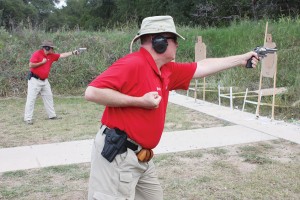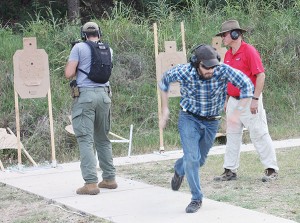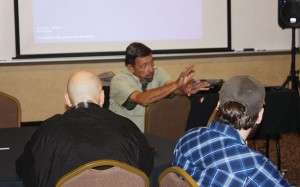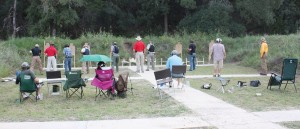by Chris Bird
If anybody had told me that I would spend the best part of two 10-hour days avidly watching a videoed talking head, I would have said he was nuts. But that is exactly what I and 14 others did recently.
We watched a series of video presentations by Massad Ayoob, nationally known author and firearms trainer of civilians and police officers. What is possibly less known about Ayoob is that since the late 1970s he has frequently been called as an expert witness in cases involving firearms and self-defense.
Ayoob, now in his mid-60s, heads the Massad Ayoob Group (MAG) and puts on classes around the country with the aid of more than 30 associate instructors. In each locale, the associate instructor conducts the range portion of the training with Ayoob presenting the classroom part. It was the two days in the classroom that formed a unique and valuable experience for anyone who regularly carries a concealed handgun for protection or even for the person who has a handgun for home defense.

Eric Lamberson (right) and Steve North demonstrating left hand shooting with revolvers at four yards.
The MAG-40 course was a four-day, 40-hour course on the “rules of engagement” for armed law-abiding private citizens. The course I attended was held in early October 2014 in the San Antonio area of Texas. It started with two days at Cedar Ridge Range taught by Eric Lamberson, one of Ayoob’s associate instructors. For the third and fourth days, we adjourned to a meeting room in a local motel.
Why the videos of Ayoob presenting the information rather than having him speaking live?
He was setting us up to win any criminal or civil case that resulted from a shooting incident that any of us might be involved in. The first thing any prosecutor or plaintiff’s lawyer is going to do is get rid of anyone from the jury who owns guns or has a concealed carry license, Ayoob said.
This means that the jury has to be educated. As Lamberson put it: “Mas cannot give the jury a five-hour course but he can show them videos that he has shown you. It’s part of the evidence.”
Ayoob said on legal advice he could not allow us to record the presentations but he encouraged us to take copious notes. We should write them up then swop them with other students to fill in parts we had not remembered or written down. We should make several copies of the final version and store them safely in several places. We should then destroy the original notes.
Ayoob recommended listing all courses we have taken, training films we have seen and relevant books that we have read. He told us to take one copy of all this, put it in an envelope and send it to ourselves by registered mail. We should not open it but keep it safe to be opened in the court if it is ever necessary. This will document our training before the incident.
If we were prosecuted or sued, we should have our lawyer call him with details of the case and request him to be an expert witness. We should not call him ourselves because anything we say to him is not privileged and can be used in court. And in case you think he was just touting for business, he added: “I do not charge my students to appear as an expert witness.”
The rule of thumb that courts will apply to a self-defense incident is: “What would a reasonable, prudent person have done under the same circumstances, knowing what the defendant knew?” Ayoob said.
Your training and knowledge prior to the incident goes to “what the defendant knew.”
Ayoob showed a video then answered questions. I found it a little discombobulating because I would be watching Ayoob life-size on a screen and at the end he would walk into view in person and I would have to switch from the image to the man.
In the 1700s, British jurist Sir William Blackstone referred to self-defense as the primary law of nature that cannot be taken away by the law of society.
Three elements have to be present to support a case of self-defense, Ayoob said.
- Ability. The person threatening you or others has to have the ability to kill or cripple. This may be because of a disparity of force between the attacker and the victim and takes into account force of numbers. Another factor is size, typically in a male attacking a female. Other factors affecting the disparity of force are youth vs. elderly; able-bodied vs. disabled; or a highly skilled attacker. Ayoob gave some court cases as examples.
- Opportunity. The attacker has to have the opportunity to use deadly force. If he is standing 100 yards away with a machete, he doesn’t have the opportunity. Whether opportunity is present is mostly determined by distance. However, obstacles in the way can be considered. Dennis Tueller, a sergeant in the Salt Lake City Police Department in the 1980s, determined that a bad guy can cover 21 feet in about a second and a half. Most people will not be able to draw from concealed and shoot the bad guy in that time. Also bear in mind that one hit at very close range is not likely to prevent him from skewering you with his ice pick. So stepping off his line of attack is a good idea. “We don’t let them get in touching distance,” Ayoob said.
- Jeopardy. The bad guy has to manifest his intent to harm by words or actions that would be interpreted by a reasonable and prudent person as putting you in imminent danger of death or serious bodily injury.
Ayoob covered the Doctrine of Competing Harms which stipulates that you are allowed to breach the law in the rare circumstances where following the law would cause more harm than breaking it. It requires a situation that is really bad and has to be dealt with immediately—exigent circumstances of extreme danger to life or limb.
He described the color codes of awareness that the late Lt.-Col. Jeff Cooper adapted from the Marine color codes. Ayoob outlined the standards of proof from mere suspicion—not founded in verifiable fact, therefore not grounds for the use of force—to beyond a reasonable doubt.
He listed nine myths about self-defense incidents starting with: If you shoot someone outside the house, drag him inside. With current advances in forensic technology, investigators can tell if you move a body. Blood spatter can pin-point the location of the body when it was hit by the bullets. There will also be transfers of microscopic debris to the body from where it was before it was dragged. If you lie to the police you will lose any credibility you may have had. Alteration of evidence is a crime and so is perjury.
One video dealt with the psychological after-effects of a shooting. The factor that tends to give people the most psychological problems is “your reaction to your society’s reaction to your shooting,” Ayoob said. Society’s reaction is indicated by trash talk in social media as well as letters and editorials in the traditional media.
“Our country doesn’t treat its heroes well,” he said.
Ayoob advised us not to disconnect any safety such as pinning the grip safety on a 1911-style handgun. He said lightening the trigger pull on a duty or concealed handgun is a bad idea and he cited the case of a Texas police sergeant who reduced the trigger pull on his Glock from five pounds to 3½ pounds. It cost his department $450,000 to defend him.

Students doing the Tueller Drill. They start back to back at three yards. The student on the right starts to sprint to see how far he can get before the other student can draw and fire. Steve North is the range officer.
Much of the fourth day in MAG 40 was devoted to what Ayoob referred to as proprietary information which he said should not be printed or put on the Internet as it might help the bad guys. Mostly it consisted of how to interact after a shooting incident with the suspect, witnesses and responding police officers.
The first two days, at Cedar Ridge Range, were taught by Lamberson of Sensible Self-Defense, assisted by Steve North. Range work included instruction in the use of the defensive handgun under stress. Lamberson, a retired Army colonel, had us practicing the draw from concealment, two-handed stances, one-handed stances with either hand, and speed reloading.
There were 12 students at the range including one federal law enforcement officer and one woman who was a nurse. The students came from Houston, Dallas, Fort Worth and Austin as well as San Antonio.
On the first day, the weather was clear with bright sunshine and the temperature working up to the low 90s. After a safety briefing, we began by learning the Weaver and Chapman stances before moving on to the Isosceles stance. Most police departments have moved away from the Weaver and Chapman stances in favor of the Isosceles stance so I asked Ayoob why he still teaches them.
“We don’t see it as either or,” he said. “It gives you more tools in the tool box.”






